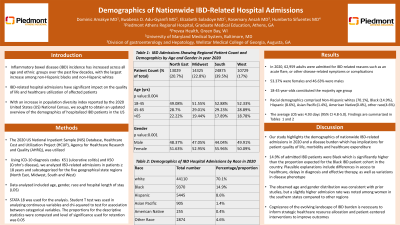Tuesday Poster Session
Category: IBD
P4270 - Demographics of Nationwide IBD-Related Hospital Admissions
Tuesday, October 29, 2024
10:30 AM - 4:00 PM ET
Location: Exhibit Hall E

Has Audio
- DA
Dominic Amakye, MBChB
Piedmont Athens Regional Medical Center
Athens, GA
Presenting Author(s)
Dominic Amakye, MBChB1, Kwabena O. Adu-Gyamfi, MD2, Elizabeth Soladoye, MD3, Rosemary Ansah, MD4, Humberto Sifuentes, MD2
1Piedmont Athens Regional Medical Center, Athens, GA; 2Augusta University, Augusta, GA; 3Piedmont Athens Regional Hospital, Athens, GA; 4WellSpan, Frederick, MD
Introduction: The incidence of inflammatory bowel disease (IBD) has increased across all demographics over the past decades, with the largest increase among non-Hispanic blacks, followed by non-Hispanic whites and other ethnic groups. IBD significantly impacts quality of life and healthcare utilization. Despite the 2020 US Census reporting increased population diversity, demographic information on hospitalized IBD patients remains limited. We sought to obtain an updated overview of the demographics of hospitalized IBD patients in the US.
Methods: We analyzed the 2020 US National Inpatient Sample (NIS) Database, using ICD-10 codes to identify IBD-related admissions (ulcerative colitis: K51, Crohn's disease: K50) among patients ≥18 years in the US, stratified by geographic region (North East, Midwest, South, West). We examined age, gender, race, and hospital length of stay using STATA 18. Statistical tests included T-tests for continuous variables and chi-squared tests for categorical associations, with a significance level of 0.05.
Results: 62,959 adults were admitted in 2020 for IBD-related reasons such as an acute flare, or other disease-related symptoms or complications. 53.37% were females and 46.63% were males. 18-45-year-olds constituted the majority age group. The racial demographics comprised non-Hispanic whites (70.1%), Black (14.9%), Hispanic (8.6%), Asian Pacific(1.4%), American Native(0.4%), and other race(4.6%). The average length of stay was 4.93 days (95% CI 4.8-5.0). Findings are summarized in Table 1.
Discussion: This study examines nationwide IBD-related admissions in 2020, highlighting implications for patient quality of life, morbidity, and healthcare expenditure. Notably, 14.9% of admitted IBD patients were Black, surpassing expected proportions for this demographic nationally. Factors such as healthcare access disparities, delayed diagnosis, and treatment effectiveness may contribute to this disparity. Racial demographics generally mirrored regional populations. Age and gender distributions aligned with previous studies, with higher admission rates among women in southern states. These findings underscore the need for informed resource allocation and patient-centered interventions to address the evolving IBD landscape and improve outcomes
Note: The table for this abstract can be viewed in the ePoster Gallery section of the ACG 2024 ePoster Site or in The American Journal of Gastroenterology's abstract supplement issue, both of which will be available starting October 27, 2024.
Disclosures:
Dominic Amakye, MBChB1, Kwabena O. Adu-Gyamfi, MD2, Elizabeth Soladoye, MD3, Rosemary Ansah, MD4, Humberto Sifuentes, MD2. P4270 - Demographics of Nationwide IBD-Related Hospital Admissions, ACG 2024 Annual Scientific Meeting Abstracts. Philadelphia, PA: American College of Gastroenterology.
1Piedmont Athens Regional Medical Center, Athens, GA; 2Augusta University, Augusta, GA; 3Piedmont Athens Regional Hospital, Athens, GA; 4WellSpan, Frederick, MD
Introduction: The incidence of inflammatory bowel disease (IBD) has increased across all demographics over the past decades, with the largest increase among non-Hispanic blacks, followed by non-Hispanic whites and other ethnic groups. IBD significantly impacts quality of life and healthcare utilization. Despite the 2020 US Census reporting increased population diversity, demographic information on hospitalized IBD patients remains limited. We sought to obtain an updated overview of the demographics of hospitalized IBD patients in the US.
Methods: We analyzed the 2020 US National Inpatient Sample (NIS) Database, using ICD-10 codes to identify IBD-related admissions (ulcerative colitis: K51, Crohn's disease: K50) among patients ≥18 years in the US, stratified by geographic region (North East, Midwest, South, West). We examined age, gender, race, and hospital length of stay using STATA 18. Statistical tests included T-tests for continuous variables and chi-squared tests for categorical associations, with a significance level of 0.05.
Results: 62,959 adults were admitted in 2020 for IBD-related reasons such as an acute flare, or other disease-related symptoms or complications. 53.37% were females and 46.63% were males. 18-45-year-olds constituted the majority age group. The racial demographics comprised non-Hispanic whites (70.1%), Black (14.9%), Hispanic (8.6%), Asian Pacific(1.4%), American Native(0.4%), and other race(4.6%). The average length of stay was 4.93 days (95% CI 4.8-5.0). Findings are summarized in Table 1.
Discussion: This study examines nationwide IBD-related admissions in 2020, highlighting implications for patient quality of life, morbidity, and healthcare expenditure. Notably, 14.9% of admitted IBD patients were Black, surpassing expected proportions for this demographic nationally. Factors such as healthcare access disparities, delayed diagnosis, and treatment effectiveness may contribute to this disparity. Racial demographics generally mirrored regional populations. Age and gender distributions aligned with previous studies, with higher admission rates among women in southern states. These findings underscore the need for informed resource allocation and patient-centered interventions to address the evolving IBD landscape and improve outcomes
Note: The table for this abstract can be viewed in the ePoster Gallery section of the ACG 2024 ePoster Site or in The American Journal of Gastroenterology's abstract supplement issue, both of which will be available starting October 27, 2024.
Disclosures:
Dominic Amakye indicated no relevant financial relationships.
Kwabena Adu-Gyamfi indicated no relevant financial relationships.
Elizabeth Soladoye indicated no relevant financial relationships.
Rosemary Ansah indicated no relevant financial relationships.
Humberto Sifuentes indicated no relevant financial relationships.
Dominic Amakye, MBChB1, Kwabena O. Adu-Gyamfi, MD2, Elizabeth Soladoye, MD3, Rosemary Ansah, MD4, Humberto Sifuentes, MD2. P4270 - Demographics of Nationwide IBD-Related Hospital Admissions, ACG 2024 Annual Scientific Meeting Abstracts. Philadelphia, PA: American College of Gastroenterology.
